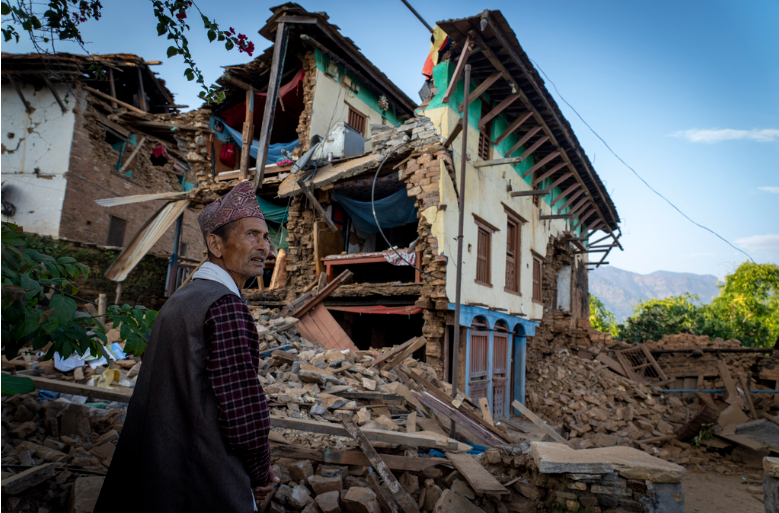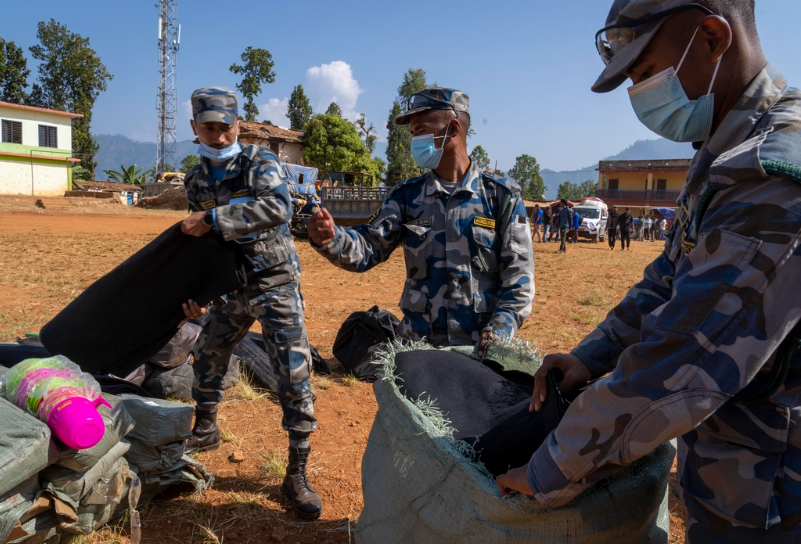Earthquakes Again Strike Nepal, Sounding Fears of Future Destruction
A man stands in front of his damaged home in the Jajarkot District in northwestern Nepal, the hardest hit district from the Friday night earthquake. Nearly all the homes in the village were damaged or destroyed. Nov. 5, 2023. (AP Photo/Niranjan Shrestha)
In the harsh aftermath of the earthquake, thousands are now left sleeping outside in the biting cold due to the fears of aftershocks. Unable to retrieve their belongings from the rubble of their homes, most were forced to shelter outside with little food or ways to keep warm. Entire villages are now preparing for more nights outside after thousands of homes were reduced to piles of bricks, many of which were built into the slopes of the mountainside.
According to reports by the United Nations Office for the Coordination of Humanitarian Affairs (OCHA), over 4,000 homes were damaged in the hardest hit regions, which include the Jajarkot district and the nearby Rukum West district. In the situation report, OCHA highlighted the vulnerability of the affected districts, which are some of the most impoverished in the country. They also expressed concerns about funding gaps to address the urgent humanitarian and recovery needs.
Rescue workers continue to push through debris to reach the affected areas, though efforts at aid are hampered by the remoteness of the mountain villages. Many can only be reached by foot, and roads were blocked by landslides caused by the quake. Jarjakot’s hospital has been filled with the wounded, and some who were severely injured have been airlifted all the way to Kathmandu for treatment.
In a statement, UNICEF Nepal said that they had dispatched emergency supplies to the hardest-hit areas of the Jajarkot and Rukum West districts. They also expressed that the full extent of the damage will continue to unfold and expect the numbers of those affected to grow.
Police work to pack relief supplies to distribute among earthquake survivors in the Jajarkot District on Monday, Nov. 6, 2023. (AP Photo/Niranjan Shrestha)
The damage caused by Friday’s earthquake is evidence of Nepal’s failure to institute stronger construction codes, despite their geologically vulnerable location. Immediately after the deadly 7.8 magnitude earthquakes that killed nearly 9,000 people in 2015, officials ordered provincial and local governments to enforce building codes.
Beyond a few major cities, enforcement has been few and far between. Even prior to 2015, there were strong fears about the potential death tolls a particularly powerful earthquake could cause due to the lack of construction regulation and disaster contingency plans.
Grieving survivors have begun to hold funerals and cremate the dead, even as a lack of aid leaves their futures uncertain. Funeral pyres were lit and burned until sunset, after which people were faced with another night out in the cold.
This most recent temblor has only exacerbated fears about the potential of a huge earthquake in Nepal, something that many scientists have predicted for many years. Nepal lies at the boundary between the Indian and Eurasian tectonic plates, making it a highly active seismic region and extremely vulnerable to bigger earthquakes. The potential for a highly devastating earthquake remains high, and should one strike, it would truly test the resources and effectiveness of the Nepalese disaster response.


